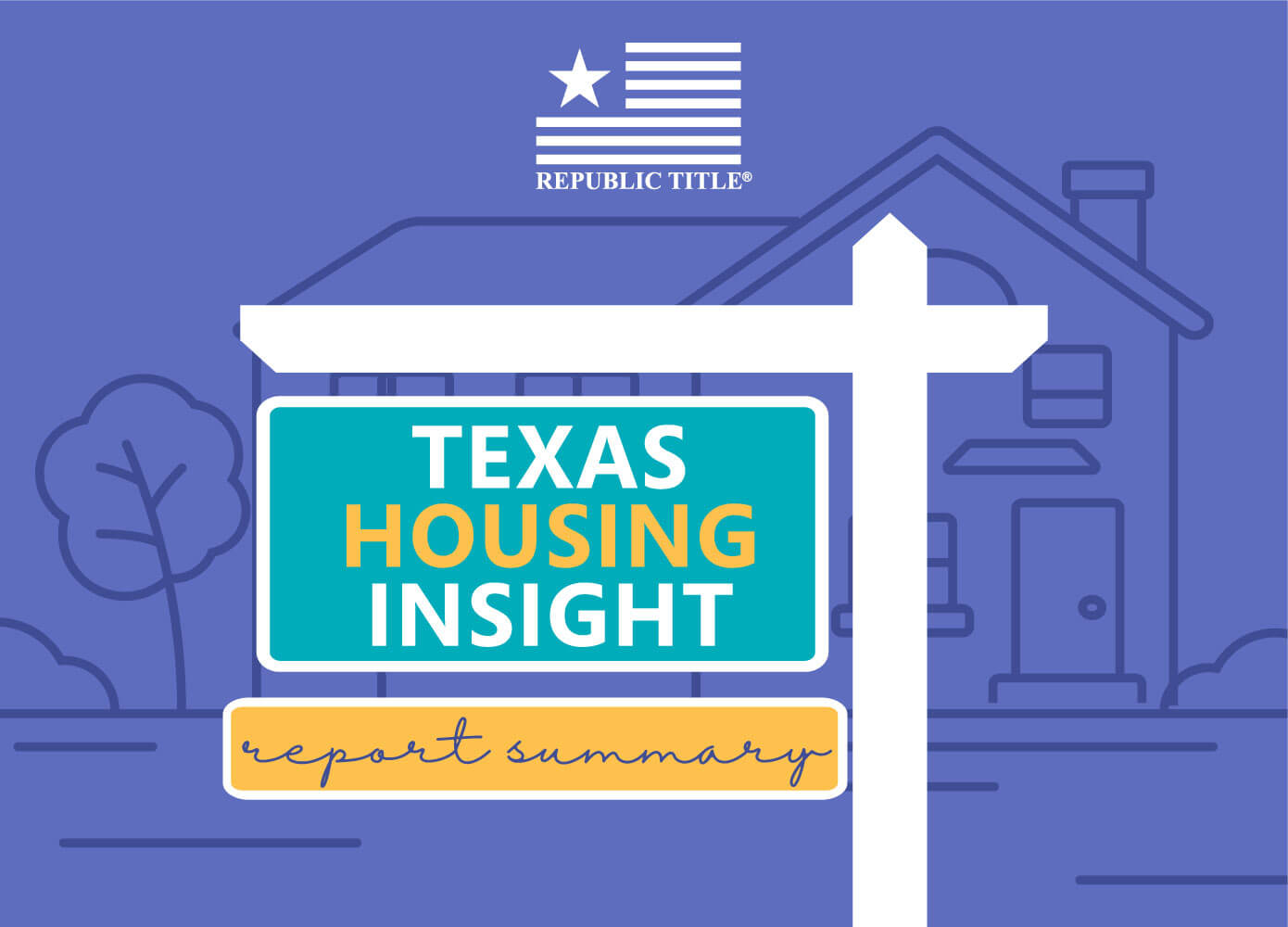
Here is the February 2020 Summary from Texas A&M Real Estate Center.

Please note this review does not account for the impacts of the COVID-19 outbreak but reflects the market through February 2020.
Prior to the domestic coronavirus outbreak, Texas housing sales increased 2.3 percent in February during healthy economic conditions and low interest rates. Housing demand was robust, although inventories were constrained, especially for homes priced less than $300,000. Strong supply-side activity, however, was poised to alleviate some shortages. Home-price appreciation accelerated, but the Repeat Sales Index suggested more moderate price growth. The coronavirus outbreak is the greatest threat to the Texas housing market via disruptions to building material supply-chains, the negative income shock, and wariness of visiting and showing homes for sale. These effects may show up in the March data but will likely have a significant impact during the second quarter of the year.
Supply*
Contemporaneous and anticipated construction levels reached post-recessionary highs in February. The Texas Residential Construction Cycle (Coincident) Index, which measures current construction levels, ticked up amid industry wage and employment improvements. Falling interest rates and increased building permits and housing starts supported growth in the Residential Construction Leading Index.
Single-family construction permits extended a yearlong upward trend, rising 1 percent. Texas led the nation with 11,211 nonseasonally adjusted permits, accounting for more than 17 percent of the U.S. total, but ranked sixth in per capita issuance. At the metropolitan level, Houston topped the list with 3,515 permits but actually declined 1.8 percent after adjusting for seasonality. Austin and Dallas comprised most of the state’s increase, issuing 1,631 and 2,486 nonseasonally adjusted permits, respectively. San Antonio permits fell to 773, but the metric remained elevated in Fort Worth at 954. In the multifamily sector, permits decreased 5.6 percent after a modest start to the year.
Texas housing starts surged 21.5 percent to its greatest post-crisis level with improvements in both the single-family and multifamily sectors. On the other hand, single-family private construction values dropped 4.7 percent after adjusting for inflation. As with permits, Houston was responsible for most of the contraction. Austin and DFW values flattened, while San Antonio only partially recovered from a 13 percent plunge in January.
Record sales and a dwindling supply of active listings pulled Texas’ months of inventory (MOI) down to an all-time low of 3.2 months. A total MOI around six months is considered a balanced housing market. The MOI for homes priced less than $300,000 fell to 2.5 months, while inventory for luxury homes (those priced more than $500,000) also declined but remained elevated at 7.5 months. This disparity exemplifies the shortage of affordable housing, although efforts have been made to more closely match demand and supply.
Inventory in the major metros decreased across the board. Austin maintained the most constrained inventory with an MOI of 1.7 months, followed by Fort Worth at 2.3 months. The Dallas and San Antonio metrics slid to 2.7 and 3.0 months, respectively. After a brief expansion to start the year, Houston’s inventory fell below 3.7 months as the metro’s supply of active listings contracted for the first time in six months, largely due to reductions in the lower price ranges.
Demand
After stalling the previous month, total housing sales during February rose 2.3 percent in an environment of low interest rates and solid employment growth. Sales for homes priced more than $400,000 accounted for much of the gain, whereas activity for homes priced less than $400,000 decelerated.
In nearly all of the major metros, sales for homes in the luxury price bracket were the greatest contributor to overall closings. Central Texas sales increased 2.2 and 2.1 percent in Austin and San Antonio, respectively, while Dallas sales rose 3 percent. Although sales for higher-priced homes in Fort Worth climbed 10.3 percent, total sales flattened as activity in other price ranges took a step back. Houston was the exception. Homes priced between $200,000-$400,000 comprised two-thirds of the city’s overall 4.8 percent improvement.
Texas’ average days on market (DOM) ticked down to 58 days, indicating healthy demand. The metric stabilized at 56 days in Houston and at 53 and 43 days in Dallas and Fort Worth, respectively. Demand was especially robust in Austin, where the DOM declined to 49 days after shedding more than a week off its year-ago level. San Antonio’s DOM ticked up slightly to 62 days but hovered around its seven-year average.
Growing concerns over the coronavirus outbreak and falling oil prices pulled interest rates down in February. The ten-year U.S. Treasury bond yield decreased to 1.5 percent, while the Federal Home Loan Mortgage Corporation’s 30-year fixed-rate fell below 3.5 percent. Mortgage applications for home purchases slowed but maintained 2.7 percent year-to-date (YTD) growth. Refinance activity remained sluggish from month to month, although the number of applications received was astronomical relative to the same period last year.
Prices
The Texas median home price accelerated 6.3 percent YOY to $249,100 as demand strengthened and inventory shrank. Austin’s median price reached double-digit YOY growth for the first time since 2015, skyrocketing nearly 13 percent to $335,600. The metric in San Antonio ($242,000) and Houston ($252,100) rose 6.8 and 6.4 percent, respectively. On the other hand, home-price appreciation softened to around 5 percent growth in North Texas, resulting in a median price of $297,500 in Dallas and $249,100 in Fort Worth.
The Texas Repeat Sales Home Price Index, a better measure of changes in single-family home values, provides insight into how Texas home prices evolve. The index indicated more moderate annual home price appreciation of 3.2 percent. Except for in San Antonio, where the metric picked up its pace to rise 3.4 percent YOY, the metropolitan indices’ growth rates slowed from the month prior. The Austin index registered just 4.6 percent growth compared with the metro’s much greater home-price appreciation. Houston’s index increased 2.8 percent, while the Dallas and Fort Worth indices rose 2.5 and 2.9 percent, respectively. Favorable housing affordability relative to other parts of the country supported the Lone Star State’s economic growth in the years following the burst of the housing bubble a decade ago. Texas needs to maintain affordability for the housing market to remain a stalwart in the impending recession and subsequent recovery.
The data reported here indicate the strength of the Texas housing market prior to the domestic COVID-19 outbreak and plunge in oil prices. The events of the past month and the economic expectations for the second half of the year will overshadow recent optimistic conditions. The government stimulus bill signed late in March allowing forbearances on federally backed mortgage loans, moratoriums on evictions, and direct financial payments to Americans earning within an income threshold will aid current homeowners, but it is unlikely to spur additional home sales. Even though we expect the real estate sector will be less affected than many other industries, the Center’s 2020 housing projections will in all probability be reached. The total impact of the impending recession on Texas’ housing market is yet to be seen.
Source – James P. Gaines, Luis B. Torres, Wesley Miller, Paige Silva, and Griffin Carter (Apr 10, 2020)
https://www.recenter.tamu.edu/articles/technical-report/Texas-Housing-Insight









